China celebrated its wealth and rising might with a show of goose-stepping troops, gaudy floats and nuclear-capable missiles in Beijing yesterday, 60 years after Mao Zedong (毛澤東) proclaimed its embrace of communism.
Tiananmen Square became a high-tech stage to celebrate the birth of the People’s Republic of China (PRC) on Oct. 1, 1949, with the Chinese Communist Party (CCP) leadership and guests watching a meticulously disciplined show of national confidence.
Celebrations began in the morning with troops firing cannons and raising the red national flag while President Hu Jintao (胡錦濤), wearing a slate grey “Mao” suit, looked on from the Gate of Heavenly Peace.
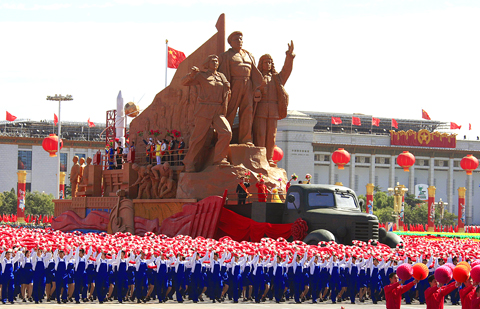
PHOTO: REUTERS
Hu descended to Beijing’s main thoroughfare and inspected rows of troops, riding past them in a black limousine and bellowing repeatedly, “Hello comrades, hard-working comrades!”
“From here it was that Chairman Mao solemnly announced the founding of the People’s Republic of China, and from then the Chinese people stood up,” Hu told the guests and troops. “Today a socialist China embracing modernization, embracing the world and embracing the future stands lofty and firm.”
The two-hour parade of 8,000 soldiers, tanks and missiles, 60 elaborate floats and 100,000 well-drilled civilians was a proud moment for many Chinese, watching the spectacle across the country on TV. Tiananmen Square was lit up last night with a huge fireworks display.
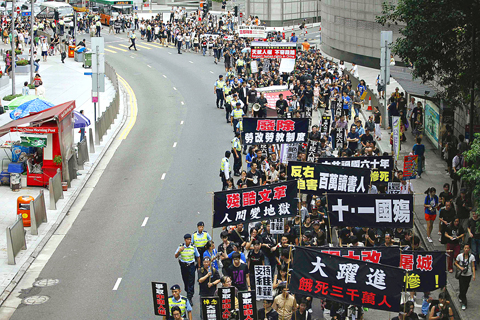
PHOTO: REUTERS
The government also wanted the day of extraordinary spectacle and security to make the case that its formula of strict one-party control and rapid growth remains the right one for hauling the world’s third-biggest economy into prosperity.
The soldiers goose-stepping past at exactly 116 steps a minute carried the theme that the CCP knows how to run a show — and the country.
“The parade is reminiscent of the old Soviet-era May Day parades that bristled with the latest missiles and served as a warning to the US,” said Wendell Minnick, Asia bureau chief of Defense News.
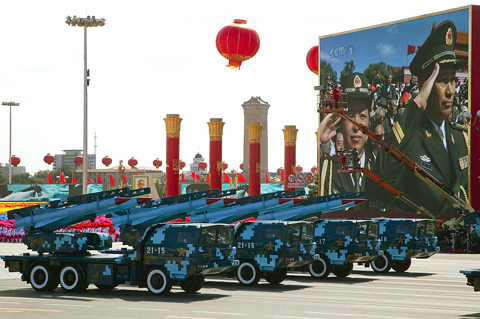
PHOTO: EPA
“For many in the US who watch the Chinese military, this is a real intelligence bonanza. Many of the weapons, particularly missiles, have not been seen by the public before. US intelligence analysts will go nuts over the photos,” he said.
“Of particular concern for the US and Japan was the display of the new road-mobile Dong Feng-31 intercontinental ballistic missile [ICBM],” Minnick said.
“China is clearly signaling to the US it has a nuclear strike capability that can hit Washington. Prior silo-based ICBMs such as the aging DF-5 were unreliable and easy for the US to target. But the new road-mobile ICBMs China is producing will be very difficult to locate during a war,” he said.
Short-range Dong Feng 11 and 15 were also displayed, he said, noting that these kinds of missiles were used during the Taiwan missile crisis of 1996.
“The parade is a clear signal to Taiwan. The variety and quality of new arms on display has to be intimidating to Taiwan military officials. China is basically saying to Taiwan independence advocates, ‘forget it, you’re going to lose.’”
But even as the displays celebrated the PRC, security cordons prevented residents from seeing the parade, with central Beijing emptied of all passers-by.
“It’s not really for us ordinary people, is it?” said Wang Chenggong, a migrant worker from Henan Province trying to watch a TV near a crowded streetside stall.
Residents on the parade route were banned from peeking out their windows.
“Go home! Leave now! Go watch TV at home!” a policeman yelled through a bullhorn at a crowd gathering kilometers from the square.
After the military parade, floats lauding China’s history, achievements and regions passed by.
They included a farm produce float with two model cows, one showing China’s space program with a lunar orbiter and an Olympic Games display with a model of the Bird’s Nest stadium.
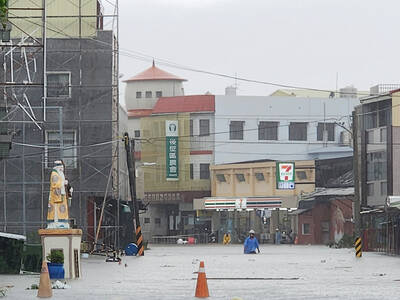
Rainfall is expected to become more widespread and persistent across central and southern Taiwan over the next few days, with the effects of the weather patterns becoming most prominent between last night and tomorrow, the Central Weather Administration (CWA) said yesterday. Independent meteorologist Daniel Wu (吳德榮) said that based on the latest forecast models of the combination of a low-pressure system and southwesterly winds, rainfall and flooding are expected to continue in central and southern Taiwan from today to Sunday. The CWA also warned of flash floods, thunder and lightning, and strong gusts in these areas, as well as landslides and fallen
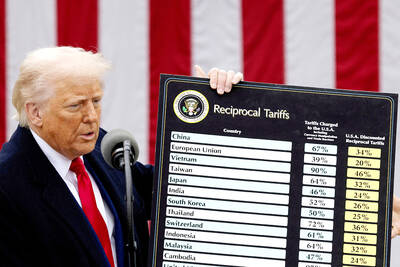
WAITING GAME: The US has so far only offered a ‘best rate tariff,’ which officials assume is about 15 percent, the same as Japan, a person familiar with the matter said Taiwan and the US have completed “technical consultations” regarding tariffs and a finalized rate is expected to be released soon, Executive Yuan spokeswoman Michelle Lee (李慧芝) told a news conference yesterday, as a 90-day pause on US President Donald Trump’s “reciprocal” tariffs is set to expire today. The two countries have reached a “certain degree of consensus” on issues such as tariffs, nontariff trade barriers, trade facilitation, supply chain resilience and economic security, Lee said. They also discussed opportunities for cooperation, investment and procurement, she said. A joint statement is still being negotiated and would be released once the US government has made
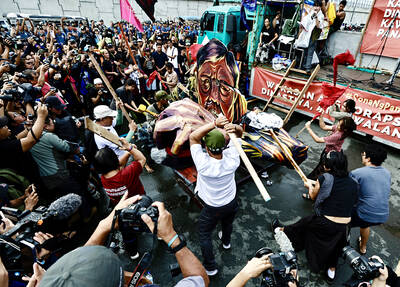
SOUTH CHINA SEA? The Philippine president spoke of adding more classrooms and power plants, while skipping tensions with China over disputed areas Philippine President Ferdinand Marcos Jr yesterday blasted “useless and crumbling” flood control projects in a state of the nation address that focused on domestic issues after a months-long feud with his vice president. Addressing a joint session of congress after days of rain that left at least 31 dead, Marcos repeated his recent warning that the nation faced a climate change-driven “new normal,” while pledging to investigate publicly funded projects that had failed. “Let’s not pretend, the people know that these projects can breed corruption. Kickbacks ... for the boys,” he said, citing houses that were “swept away” by the floods. “Someone has

‘CRUDE’: The potential countermeasure is in response to South Africa renaming Taiwan’s representative offices and the insistence that it move out of Pretoria Taiwan is considering banning exports of semiconductors to South Africa after the latter unilaterally downgraded and changed the names of Taiwan’s two representative offices, the Ministry of Foreign Affairs (MOFA) said yesterday. On Monday last week, the South African Department of International Relations and Cooperation unilaterally released a statement saying that, as of April 1, the Taipei Liaison Offices in Pretoria and Cape Town had been renamed the “Taipei Commercial Office in Johannesburg” and the “Taipei Commercial Office in Cape Town.” Citing UN General Assembly Resolution 2758, it said that South Africa “recognizes the People’s Republic of China (PRC) as the sole